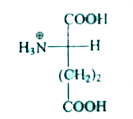Which of the following is the major solute species in a solution of lysine at pH=10.5 ?




The correct Answer is:4
To determine the major solute species in a solution of lysine at pH 10.5, we need to analyze the structure of lysine and how it behaves in a basic medium.
1. Understand the Structure of Lysine:
- Lysine is an amino acid with the following structure:
H2N−(CH2)4−COOH
- It contains an amino group (-NH2) and a carboxylic acid group (-COOH).
2. Identify the pH Context:
- The pH of the solution is 10.5, which indicates a basic environment. In basic solutions, the concentration of hydroxide ions (OH-) is high.
3. Behavior of the Carboxylic Acid Group in Basic Medium:
- In a basic medium, the carboxylic acid group (-COOH) can lose a proton (H+). This results in the formation of a carboxylate ion (-COO^-):
COOH→COO−+H+
4. Behavior of the Amino Group:
- The amino group (-NH2) can remain protonated or deprotonated depending on the pH. At pH 10.5, it is likely that the amino group remains in its deprotonated state (-NH2), as the pKa of the amino group is typically around 9.0.
5. Final Structure in Basic Medium:
- Therefore, at pH 10.5, lysine predominantly exists in the form:
H2N−(CH2)4−COO−
- This indicates that the carboxylic acid group is deprotonated, while the amino group remains unprotonated.
6. Identify the Major Solute Species:
- The major solute species in a solution of lysine at pH 10.5 is the deprotonated form of lysine with the carboxylate ion.
Conclusion:
The major solute species in a solution of lysine at pH 10.5 is:
H2N−(CH2)4−COO−
- Lysine is an amino acid with the following structure:
H2N−(CH2)4−COOH
- It contains an amino group (-NH2) and a carboxylic acid group (-COOH).
- The pH of the solution is 10.5, which indicates a basic environment. In basic solutions, the concentration of hydroxide ions (OH-) is high.
- In a basic medium, the carboxylic acid group (-COOH) can lose a proton (H+). This results in the formation of a carboxylate ion (-COO^-):
COOH→COO−+H+
- The amino group (-NH2) can remain protonated or deprotonated depending on the pH. At pH 10.5, it is likely that the amino group remains in its deprotonated state (-NH2), as the pKa of the amino group is typically around 9.0.
- Therefore, at pH 10.5, lysine predominantly exists in the form:
H2N−(CH2)4−COO−
- This indicates that the carboxylic acid group is deprotonated, while the amino group remains unprotonated.
- The major solute species in a solution of lysine at pH 10.5 is the deprotonated form of lysine with the carboxylate ion.
The major solute species in a solution of lysine at pH 10.5 is:
H2N−(CH2)4−COO−
Topper's Solved these Questions
- BIOMOLECULES & POLYMERBook:RESONANCE ENGLISHChapter:BIOMOLECULES & POLYMERExercise:ORGANIC CHEMISTRY(Biomolecules & Polymer)
Explore 34 Videos
- BIOMOLECULESBook:RESONANCE ENGLISHChapter:BIOMOLECULESExercise:Advanced Level(Part II)
Explore 33 Videos
- CARBONYL COMPOUNDS (ALDEHYDES & KETONES ) & CARBOXYLIC ACID Book:RESONANCE ENGLISHChapter:CARBONYL COMPOUNDS (ALDEHYDES & KETONES ) & CARBOXYLIC ACID Exercise:Part -IV
Explore 23 Videos
Similar Questions
Knowledge Check
Which of the following is the major solute species in a solution of glutamic acid at pH = 1.3?
A B
B C
C D
D
Which of the following solutions will have pH close to 1.0?
A100 mL of M/10 HCl+100 mL of M/10 NaOHB55 mL of M/10 HCl+45mL of M/10 NaOHC10 mL of M/10 HCl+90mL of M/10 NaOHD75 mL of M/10 HCl+25mL of M/10 NaOH
Which of the following solutions have pH<7.
View SolutionWhich of the following solutions has the highest pH?
View SolutionWhich one of the following species is stable in aqueous solution?
View SolutionWhich of the following solutions has pH=12?
View SolutionWhich of the following salt solutions has pH<7 ? .
View SolutionWhich of the following when mixed, will given a solution with pH>7.
View Solution

